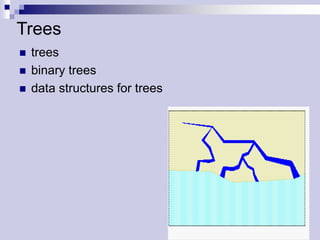
Lec6
- 1. Trees trees binary trees data structures for trees 1
- 2. Trees: Definitions A is the root node. B is parent of D & E. A is ancestor of D & E. D and E are descendants of A. C is the sibling of B D and E are the children of B. D, E, F, G, I are leaves. 2
- 3. Trees: Definitions (2) A, B, C, H are internal nodes The depth (level) of E is 2 The height of the tree is 3 The degree of node B is 2 level 0 level 1 level 2 level 3 3
- 4. Trees A tree represents a hierarchy, for e.g. the organization structure of a corporation Or table of contents of a book 4
- 5. Another Example Unix or DOS/Windows file system 5
- 6. Binary Tree An ordered tree is one in which the children of each node are ordered. Binary tree: ordered tree with all nodes having at most 2 children. 6
- 7. Recursive definition of binary tree A binary tree is either a leaf or An internal node (the root) and one/two binary trees (left subtree and/or right subtree). 7
- 8. Examples of Binary Trees arithmetic expressions 8
- 9. Examples of Binary Trees decision trees 9
- 10. Complete Binary tree level i has 2i nodes In a tree of height h leaves are at level h No. of leaves is 2h h No. of internal nodes = 1+2+22+…+2h-1 = 2 -1 No of internal nodes = no of leaves -1 Total no. of nodes is 2h+1-1 = n In a tree of n nodes No of leaves is (n+1)/2 Height = log2 (no of leaves) 10
- 11. Binary Tree A Binary tree can be obtained from an appropriate complete binary tree by pruning 11
- 12. Minimum height of a binary tree A binary tree of height h has At most 2i nodes at level i At most 1+2+22+…+2h = 2h+1-1 nodes If the tree has n nodes then n <= 2h+1-1 Hence h >= log2 (n+1)/2 12
- 13. Maximum height of a binary tree A binary tree on n nodes has height at most n-1 This is obtained when every node (except the leaf) has exactly one child 13
- 14. No of leaves in a binary tree no of leaves <= 1+ no of internal nodes. Proof: by induction on no of internal nodes Tree with 1 node has a leaf but no internal node. Assume stmt is true for tree with k-1 internal nodes. A tree with k internal nodes has k1 internal nodes in left subtree and (k-k1-1) internal nodes in right subtree. No of leaves <= (k1+1)+(k-k1) = k+1 14
- 15. leaves in a binary tree (2) For a binary tree on n nodes No of leaves + no of internal nodes = n No of leaves <= no of internal nodes + 1 Hence, no of leaves <= (n+1)/2 Minimum no of leaves is 1 15
- 16. ADTs for Trees generic container methods: size(), isEmpty(), elements() positional container methods: positions(), swapElements(p,q), replaceElement(p,e) query methods: isRoot(p), isInternal(p), isExternal(p) accessor methods: root(), parent(p), children(p) update methods: application specific 16
- 17. ADTs for Binary Trees accessor methods: leftChild(p), rightChild(p), sibling(p) update methods: expandExternal(p), removeAboveExternal(p) other application specific methods 17
- 18. The Node Structure Each node in the tree contains key[x] – key left[x] – pointer to left child right[x] – pt. to right child p[x] – pt. to parent node 18
- 19. Representing Rooted Trees BinaryTree: Root Parent: BinaryTree LeftChild: BinaryTree RightChild: BinaryTree 19
- 20. Unbounded Branching UnboundedTree: Root Parent: UnboundedTree LeftChild: UnboundedTree RightSibling: UnboundedTree 20
